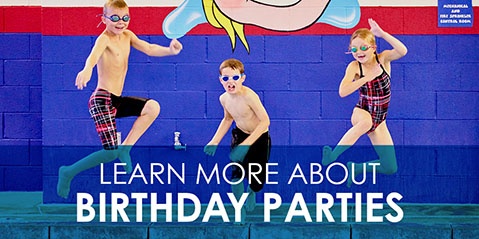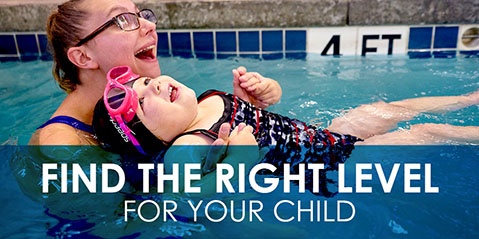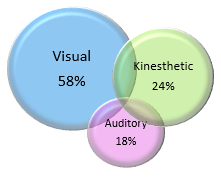
"I've always been fortunate in that I've been able to put myself in my own zone and relax. It comes naturally. I'm lucky to be that way" - Michael Phelps
Kids, like the rest of us, all have their own learning style. Some of us learn through what we see. Some learn by recalling what we have heard. Others learn through imitating examples. Part of the job of a swim instructor is learning and identifying how children and students are processing information as they try to learn or hone a new skill. How can we facilitate that learning and give them the best swim instruction? How can we communicate with a student in their 'own zone' and help them naturally excel? The first step often comes in recognizing there is a definite way some students learn.
3 Ways Kiddos Learn to Swim
Kiddos use their senses to learn and do not use just one sense exclusively; however, kiddos have a sense that they use predominately to learn.
- Some kiddos
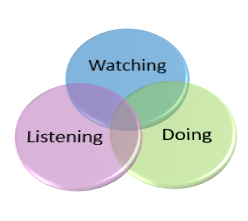 learn to swim predominately by watching,
learn to swim predominately by watching, - some kiddos learn to swim predominately by listening, and
- some kiddos learn to swim predominately by doing
Visual Style of Learning
The kiddos that learn to swim by watching are considered Visual Learners. They have keen observation skills and think in terms of visual images. Considered the most dominant style, about 58 percent of the U.S. population prefer visual style learning. [i]
Familiar Traits Identifying Visual Learners
- Needs to see it to know it
- Absorbed in watching other students
- Looks up at parents a lot
- Misinterprets words
- Seldom wants to go first
- Ability to read body language
Auditory Style of Learning
The kiddos that learn to swim by listening are considered 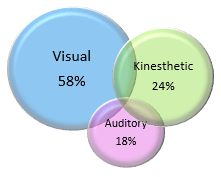 Auditory Learners. They have strong listening skills and think in terms of spoken words. Considered the least dominate style, about only 18 percent of the U.S. population prefers the Auditory style of learning.1
Auditory Learners. They have strong listening skills and think in terms of spoken words. Considered the least dominate style, about only 18 percent of the U.S. population prefers the Auditory style of learning.1
Familiar Traits Identifying Auditory Learners
- Tends to ask a lot of questions
- Often repeats what you say.
- Talks a lot with fellow students
- Finds it difficult to work quietly for extended periods of time
- Might seem introverted
Kinesthetic Style of Learning
The Kiddos that learn to swim by doing are considered Kinesthetic Learners. They relate to physical movement and body control. Kinesthetic learners represent about 24 percent of the U.S. population.1 These might be the toughest kiddos to teach to swim because they don’t learn by demonstration or verbal instruction.
Familiar Traits Identifying Kinesthetic Learners
- Has difficulty sitting still
- Prefers physical touching
- Always moving
- Often interrupts others
- Does not seem to pay attention
- Wants to go first then asks “what are we doing?”
The Best Way to Teach Kiddos to Swim
Because there are actually 3 styles of learning to swim, there are 3 ways to teach swimming.
Teaching “Watchers” to Swim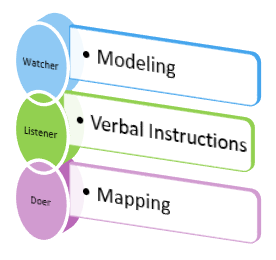
The best way to teach a “Watcher” to swim is to fulfill the need to see it. This can be accomplished through modeling. Modeling is defined as “an instructional strategy in which the teacher demonstrates a new concept or approach to learning and students learn by observing.” These kiddos are taught by physically demonstrating the particular swimming skills and have the students mimic those skills. (Caution should be taken: since “watchers” learn by observing all their surroundings kiddos can pick up bad habits from other students.)
Teaching “Listeners” to Swim
The best way to teach “Listeners” to swim is to fulfill the need to hear it. This can be accomplished by verbally breaking down the steps, repeating the instructions multiple times, and even having them repeat the instructions back to you out loud. Songs and nursery rhymes are often helpful for “Listeners.”
Teaching “Doers” to Swim
The best way to teach “Doers” is to fulfill their need to try it. This can be accomplished by mapping. A portion of mapping is based on the concept that learning occurs as students are actively involved in the process. Instructors can physically guide these students through the motions of the swimming skills. An example would be moving the kiddos legs in the motion of the “frog kick”. Remember it’s important to keep “doers” busy. Provide toys such as ducks, balls etc. to give them something to do with their hands while waiting to practice the skills.
Because classes can be so diverse with different styles of learners, a program should be geared to all three learning styles. So, what’s the best way to teach swimming? The best teaching tools are to individualize the instruction and use all three teaching methods!
Do you want to learn where your child's swim level is? Use our Swim Level Wizard below to help identify your kiddo's current swim ability!
[i] Jones, D. C. (2010).

